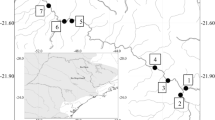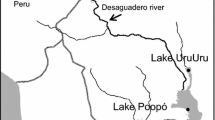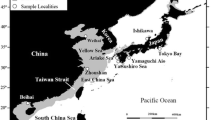Abstract
Identification of masu salmon Oncorhynchus masou masou and amago salmon O. m. ishikawae was accomplished using a random amplified polymorphic DNA (RAPD) technique. Of 80 primers screened, three primers amplified subspecies-specific fragments (OPA11-1095 *, OPB5-1618* and OPD5-2038 *). Based on fragment patterns, 33 hybrids were detected among 150 upstream-migrating individuals in the Jinzu River, central Japan, a long-time habitat of masu salmon, to which amago salmon were recently introduced. All of the individuals examined in the 2000–2002 cohorts were identified as F 1 and F x as well as pure masu and amago forms. These results indicated continuing hybridization, the genetic pollution of the native masu salmon population by amago salmon possibly being a serious problem in the Jinzu River. Both standard length and body weight in F 1 hybrids tended to be less than in pure masu salmon. However, F x hybrids showed similar body sizes to masu salmon.
Similar content being viewed by others
References
Primack RB A. Primer of Conservation Biology. Sinauer Associates Inc, Sunderland, Massachusetts, USA. 1995.
Yodo T, Kimura S. Feeding habits of largemouth bass Micropterus salmoides in Lakes Shorenji and Nishinoko, Central Japan. Nippon Suisan Gakkaishi 1998; 64: 26–28.
Takahashi K. Influence for fish community by largemouth bass, one example of Izunuma and Uchinuma ponds. In: The Ichthyological Society of Japan (ed). Invader in Rivers and Lakes, Black Bass: its Biology and Influence for Ecosystem. Kouseisha, Tokyo. 2002; 47–59.
Frankham R, Ballou JD, Briscoe DA. Introduction to Conservation Genetics. Cambridge University Press, Cambridge, UK. 2002.
Sakai H. Hybridization and conservation. Aquabiol 1999; 21: 330–337.
Sakai H. Natural hybridization and speciation in fishes. Seibutsukagaku 1995; 47: 113–123.
Tago Y. Occurrence of red spotted masu salmon in the Jinzu River, Toyama, where natively distribution of masu salmon. Suisanzoshoku 2002; 50: 137–142.
Tago Y. Recent decrease in mean body weight of adult masu salmon caught in the Jinzu River. Suisanzoshoku 2002; 50: 387–391.
Numachi K. Genetic divergence and phylogenetic relationships among salmonid fishes based on allozyme analyses. Iden 1984; 38: 4–11.
Kobayashi T. Genetic diversity in masu salmon from Japan, deduced from mtDNA RFLP analysis. News Nat. Res. Inst. Aquac. 1993; 26: 2–8.
Murata S, Takasaki N, Okazaki T, Kobayashi T, Numachi K, Chang KH, Okada N. Molecular evidence from short interspersed elements (SINEs) that Oncorhynchusmasou (cherry salmon) is monophyletic. Can. J. Fish. Aquat. Sci. 1998; 55: 1864–1870.
Williams JGK, Kubelik AR, Livak KJ, rafalski JA, Tingey SV. DNA polymorphisms amplified by arbitrary primers are useful as genetic markers. Nucl. Acids Res. 1990; 18: 6531–6535.
Morgan-Richards M, Wolff K. Genetic structure and differentiation of Plantago major reveals a pair of sympatric sister species. Mol. Ecol. 1999; 8: 1027–1036.
Bielawski JP, Pumo DE. Randomly amplified polymorphic DNA (RAPD) analysis of Atlantic Coast striped bass. Heredity 1997; 78: 32–40.
Callejas C, Ochando MD. Identification of Spanish barbel species using the RAPD technique. J. Fish Biol. 1998; 53: 208–215.
Barman HK, Barat A, Yadav BM, Banerjee S, Meher KP, Reddy PVGK, Jana RK. Genetic variation between four species of Indian major carps as revealed by random amplified polymorphic DNA assay. Aquaculture 2003; 217: 115–123.
Elo K, Ivanoff S, Vuorinen JA, Piironen J. Inheritance of RAPD markers and detection of interspecific hybridization with brown trout and Atlantic salmon. Aquaculture 1997; 152: 55–65.
Yamaki M, Yamashita H, Satou M, Satou H. Verification of hybrid nature of diploid and triploid progeny between amago salmon and Japanese char by RAPD-PCR analysis. Suisanzoushoku 1999; 47: 35–41.
Mogi H, Honjyo T, Tachikawa W. On the hybridization of between salmon, Oncorhynchusmasou, and amago salmon, O. rhodurus — I. On the hereditary character of hybrids. Rep. Gifu Pref. Fresh Water Fish Res. Ins. 1975; 20: 55–60.
Harada Y. Mathematical studies on the effect of a brood-stock management practice on the direct genetic effects of hatchery release. Fish Genet. Breed. Sci. 1999; 27: 15–31.
Kawanabe H, Mizuno N, Hosoya H. Freshwater Fishes of Japan. Yama-to-Keikoku-sha, Tokyo, Japan, 1989.
Author information
Authors and Affiliations
Corresponding author
Rights and permissions
About this article
Cite this article
Yamazaki, Y., Shimada, N. & Tago, Y. Detection of hybrids between masu salmon Oncorhynchus masou masou and amago salmon O. m. ishikawae occurred in the Jinzu River using a random amplified polymorphic DNA technique. Fish Sci 71, 320–326 (2005). https://doi.org/10.1111/j.1444-2906.2005.00967.x
Received:
Accepted:
Issue Date:
DOI: https://doi.org/10.1111/j.1444-2906.2005.00967.x




